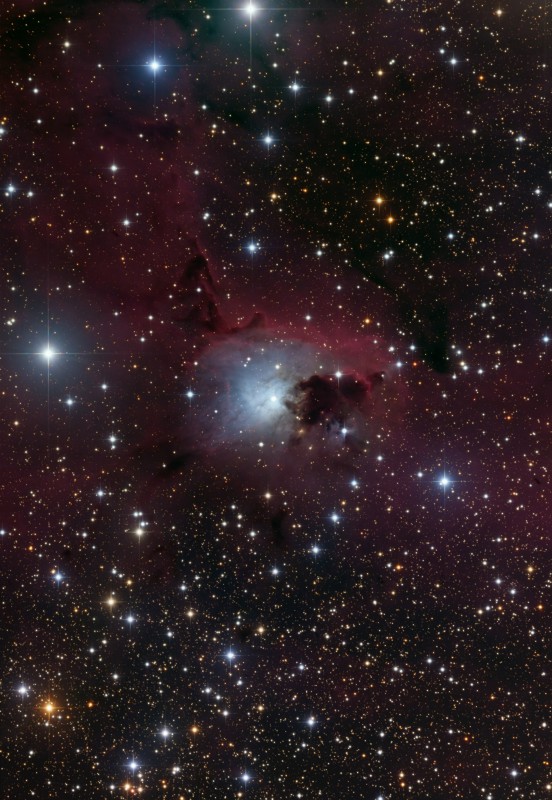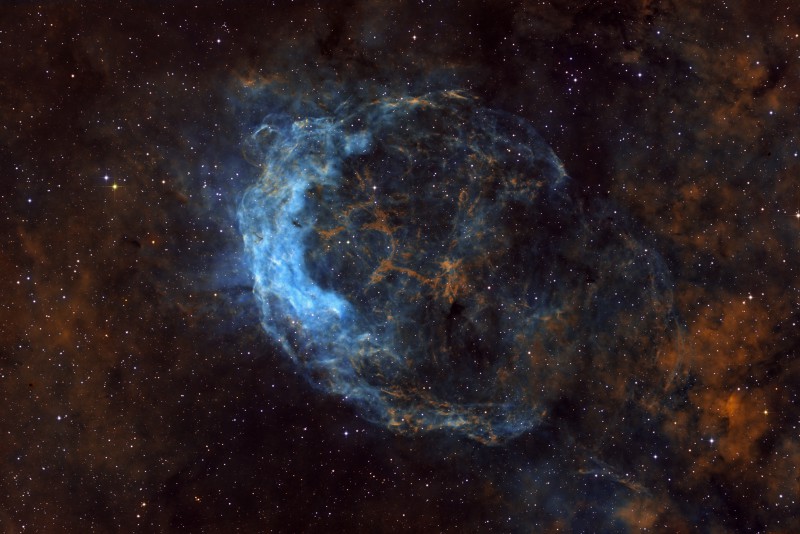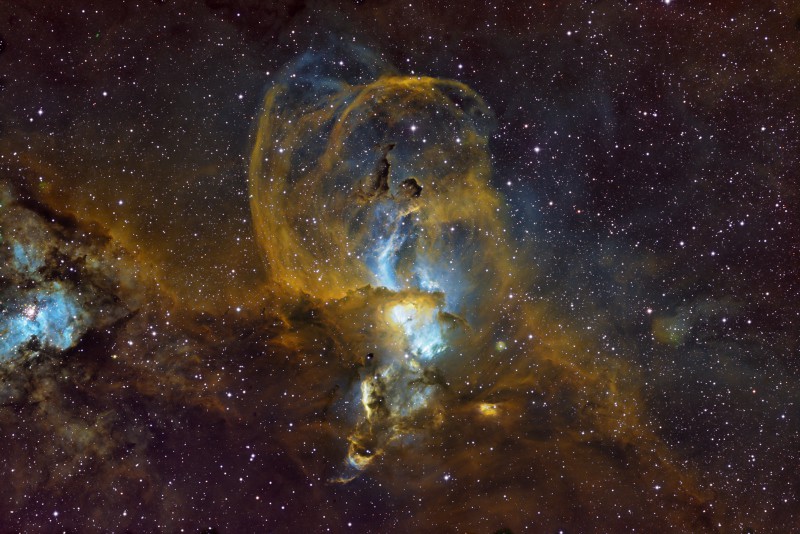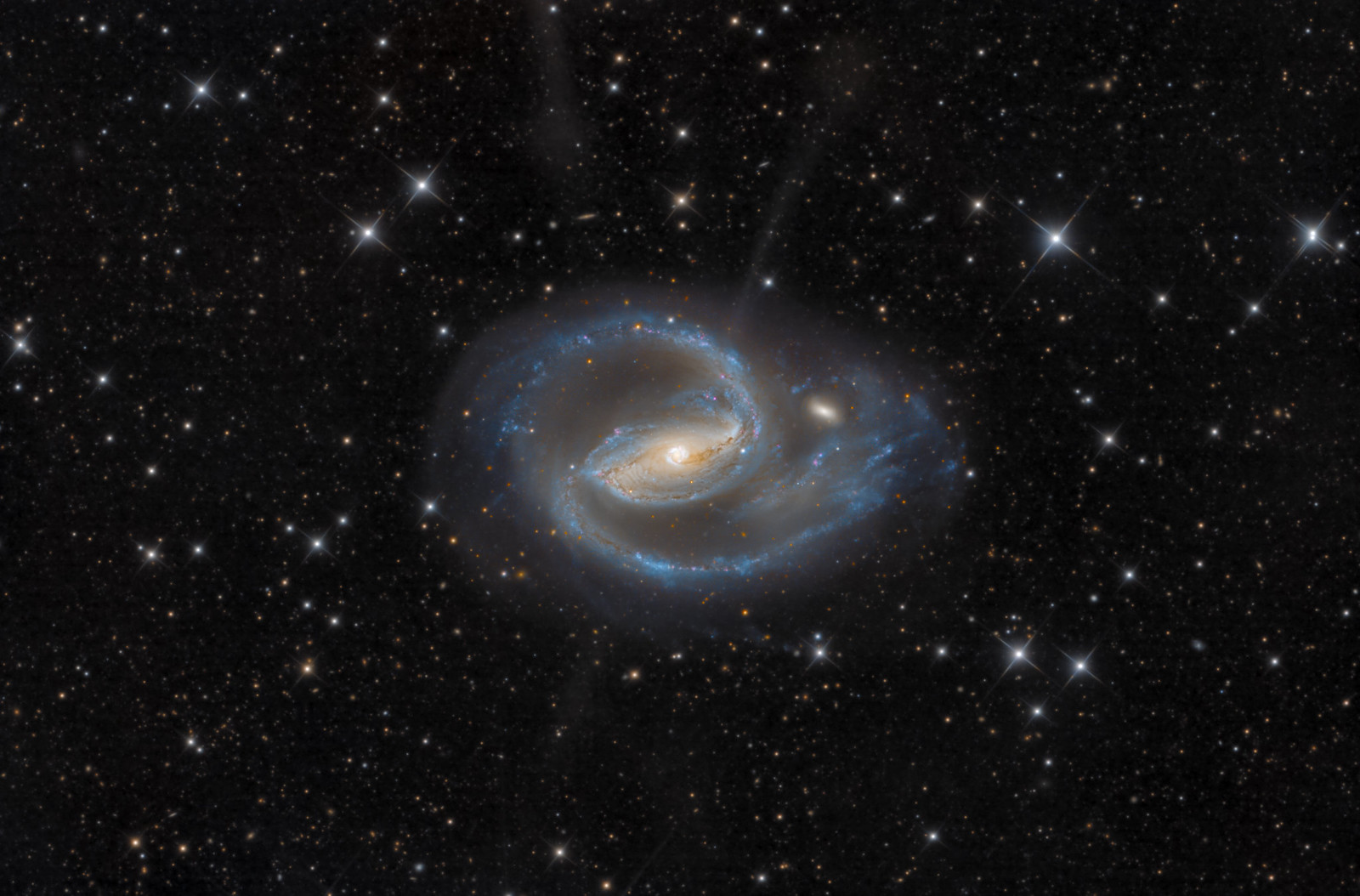Submissions: 2022 March
-
Meiying Lee
- Ensign
- Posts: 64
- Joined: Sun Aug 15, 2021 8:28 am
Re: Submissions: 2022 March
Ice Halos- 9° halo、22° Circular halo、Circumscribed halo and Parhelic circle
On March 16th, I was at the top of the 2300-meter Jhenshan trail near Hsinchu, and I encountered beautiful ice halos near noon! At that time, the altitude of the sun was about 60°. First I saw the 22° circular halo and circumscribed halo, and even more surprising is the super strong 9° halo. I'm just so happy! The 9°halo is one of the 'Odd radius halos'. They are special halos formed by pyramidal ice crystals, which are not very common. Later, I found that there is a white arc outside the 22° halo. If you look closely, it turns out to be a parhelic circle passing through the sun! These beautiful ice halos seem to herald the coming of halo season, which is full of anticipation.
Photographer : Meiying Lee (李美英) Equipment Details: iPhone 13 Pro
Location : Hsinchu, Taiwan
Time: March 16, 2022
On March 16th, I was at the top of the 2300-meter Jhenshan trail near Hsinchu, and I encountered beautiful ice halos near noon! At that time, the altitude of the sun was about 60°. First I saw the 22° circular halo and circumscribed halo, and even more surprising is the super strong 9° halo. I'm just so happy! The 9°halo is one of the 'Odd radius halos'. They are special halos formed by pyramidal ice crystals, which are not very common. Later, I found that there is a white arc outside the 22° halo. If you look closely, it turns out to be a parhelic circle passing through the sun! These beautiful ice halos seem to herald the coming of halo season, which is full of anticipation.
Photographer : Meiying Lee (李美英) Equipment Details: iPhone 13 Pro
Location : Hsinchu, Taiwan
Time: March 16, 2022
- the_astronomy_enthusiast
- Ensign
- Posts: 98
- Joined: Fri Apr 16, 2021 10:16 pm
- Contact:
Re: Submissions: 2022 March
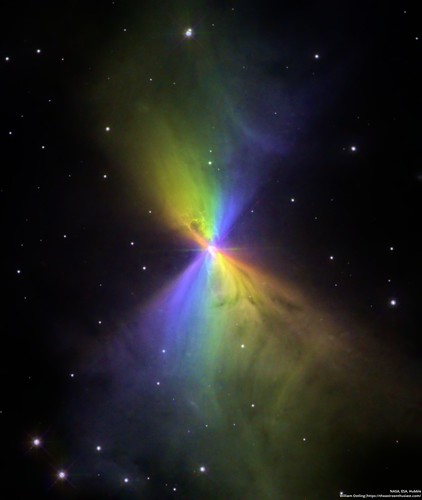
Hubble's view of the boomerang nebula by William Ostling, on Flickr
Full write-up here: https://theastroenthusiast.com/the-boom ... om-hubble/
The Hubble Space Telescope has “caught” the Boomerang Nebula in these new images taken with the Advanced Camera for Surveys. This reflecting cloud of dust and gas has two nearly symmetric lobes (or cones) of matter that are being ejected from a central star. Over the last 1,500 years, nearly one and a half times the mass of our Sun has been lost by the central star of the Boomerang Nebula in an ejection process known as a bipolar outflow. The nebula’s name is derived from its symmetric structure as seen from ground-based telescopes. Hubble’s sharp view is able to resolve patterns and ripples in the nebula very close to the central star that are not visible from the ground.
A visible light filter was used in combination with a series of polarization filters. Similar to polarizing sunglasses that are used to reduce the amount of scattered light that enters our eyes on a sunny day, the telescope’s polarizing filters allow only light of a specific polarization angle to pass through to the camera’s detector. By combining images taken at different polarization angles, astronomers can study light scattering in the nebula and the properties of the small dust particles responsible for the scattering. Colors were assigned to represent different polarization components, and then those colors were adjusted to accentuate features in the nebula, resulting in the multi-hued composite image.
The Boomerang Nebula is located about 5,000 light-years from Earth in the direction of the Southern constellation Centaurus. Submillimeter radio measurements made in 1995 show the deep interior of the nebula to have a temperature of only one degree Kelvin above absolute zero, with absolute zero equal to nearly -460 degrees Fahrenheit. This makes the inner regions of the Boomerang Nebula one of the coldest known places in the universe.
Website: https://theastroenthusiast.com/
Instagram: https://www.instagram.com/the_astronomy_enthusiast/
-
tommasostella
- Ensign
- Posts: 56
- Joined: Mon Nov 11, 2019 4:34 pm
Re: Submissions: 2022 March
Brocchi's Cluster (CR 399)
https://www.facebook.com/tommaso.m.stella
Copyright: Tommaso Stella
From: Taranto-Italy
Takahashi FS60@f/4.2 + QHY168C
Lights: 20x300s
https://www.facebook.com/tommaso.m.stella
Copyright: Tommaso Stella
From: Taranto-Italy
Takahashi FS60@f/4.2 + QHY168C
Lights: 20x300s
-
wrightdobbs
- Ensign
- Posts: 26
- Joined: Wed Jan 19, 2022 10:42 pm
Re: Submissions: 2022 March
"NASA SLS Rocket's First Morning on the Launchpad"
Captured at Cape Canaveral Seashore National Park, Florida.
"The first morning on the launchpad (LC-39B) for NASA's Space Launch System Rocket. The SLS rocket will eventually take astronauts to the moon for the first time since the Apollo missions on the Artemis 2 mission. The SLS Rocket is about as tall as the Saturn V rocket of the Apollo Era. The rocket pictured here is for the Artemis 1 mission."
Photo by Me.
Imaging camera was Nikon D3300, 200mm, f/5.6, 1s, ISO 200.
https://twitter.com/WrightDobbs
https://www.facebook.com/wrightdobbsphotography
https://instagram.com/wrightdobbs
[/quote]
Captured at Cape Canaveral Seashore National Park, Florida.
"The first morning on the launchpad (LC-39B) for NASA's Space Launch System Rocket. The SLS rocket will eventually take astronauts to the moon for the first time since the Apollo missions on the Artemis 2 mission. The SLS Rocket is about as tall as the Saturn V rocket of the Apollo Era. The rocket pictured here is for the Artemis 1 mission."
Photo by Me.
Imaging camera was Nikon D3300, 200mm, f/5.6, 1s, ISO 200.
https://twitter.com/WrightDobbs
https://www.facebook.com/wrightdobbsphotography
https://instagram.com/wrightdobbs
[/quote]
-
Sebastian Voltmer
- Ensign
- Posts: 67
- Joined: Tue Jan 17, 2012 11:45 pm
Re: Submissions: 2022 March
ISS captured from Earth
Currently I was able to take this images of the International Space Station (ISS) under best viewing conditions (seeing) captured from the hometown of the ESA astronaut Dr. Matthias Maurer. The resolution of the images shows details around 20 cm. The docked SpaceX Dragon capsule, with which the current Crew-3 flew to the ISS, can be clearly seen. A wave from Matthias is likely to be spotted 400 km above his hometown of Oberthal, Germany, during his spacewalk on Wednesday.
See also the 3D insert and the new video:
https://www.youtube.com/watch?v=peozuHG ... Mg&index=3
All pictures were taken very early in the morning of 7 March 2022.
Happy Birthday to Matthias Maurer (March 18)!
Clear skies,
Sebastian
www.weltraum.com
Dr. Sebastian Voltmer
Currently I was able to take this images of the International Space Station (ISS) under best viewing conditions (seeing) captured from the hometown of the ESA astronaut Dr. Matthias Maurer. The resolution of the images shows details around 20 cm. The docked SpaceX Dragon capsule, with which the current Crew-3 flew to the ISS, can be clearly seen. A wave from Matthias is likely to be spotted 400 km above his hometown of Oberthal, Germany, during his spacewalk on Wednesday.
See also the 3D insert and the new video:
https://www.youtube.com/watch?v=peozuHG ... Mg&index=3
All pictures were taken very early in the morning of 7 March 2022.
Happy Birthday to Matthias Maurer (March 18)!
Clear skies,
Sebastian
www.weltraum.com
Dr. Sebastian Voltmer
Last edited by Sebastian Voltmer on Sat Mar 19, 2022 1:47 am, edited 1 time in total.
- the_astronomy_enthusiast
- Ensign
- Posts: 98
- Joined: Fri Apr 16, 2021 10:16 pm
- Contact:
Re: Submissions: 2022 March

Hubble's Ultra deep Field by William Ostling, on Flickr
Full write up here: https://theastroenthusiast.com/hubbles- ... -galaxies/
Galaxies, galaxies everywhere – as far as NASA’s Hubble Space Telescope can see. This view of nearly 10,000 galaxies is the deepest visible-light image of the cosmos. Called the Hubble Ultra Deep Field, this galaxy-studded view represents a “deep” core sample of the universe, cutting across billions of light-years. The snapshot includes galaxies of various ages, sizes, shapes, and colors. The smallest, reddest galaxies, about 100, may be among the most distant known, existing when the universe was just 800 million years old. The nearest galaxies – the larger, brighter, well-defined spirals and ellipticals – thrived about 1 billion years ago, when the cosmos was 13 billion years old.
In vibrant contrast to the rich harvest of classic spiral and elliptical galaxies, there is a zoo of oddball galaxies littering the field. Some look like toothpicks; others like links on a bracelet. A few appear to be interacting. These oddball galaxies chronicle a period when the universe was younger and more chaotic. Order and structure were just beginning to emerge. In ground-based photographs, the patch of sky in which the galaxies reside (just one-tenth the diameter of the full Moon) is largely empty. Located in the constellation Fornax, the region is so empty that only a handful of stars within the Milky Way galaxy can be seen in the image.
In this image, blue and green correspond to colors that can be seen by the human eye, such as hot, young, blue stars and the glow of Sun-like stars in the disks of galaxies. Red represents near-infrared light, which is invisible to the human eye, such as the red glow of dust-enshrouded galaxies. The image required 800 exposures taken over the course of 400 Hubble orbits around Earth. The total amount of exposure time was 11.3 days, taken between Sept. 24, 2003 and Jan. 16, 2004.
Website: https://theastroenthusiast.com/
Instagram: https://www.instagram.com/the_astronomy_enthusiast/
-
tommasostella
- Ensign
- Posts: 56
- Joined: Mon Nov 11, 2019 4:34 pm
Re: Submissions: 2022 March
M1 Crab nebula
https://www.facebook.com/tommaso.m.stella
Copyright: Tommaso Stella
From: Taranto-Italy
The photo is the fusion of shots taken with two different telescopes, both with short poses and without autoguiding
Technical data
--------------
Lights: 985x10s (250/f5) + 382x40s (200 f/4)
Telescope1: Newton GSO 880 Deluxe 250/1250 + GPU Aplanatic coma corrector
Telescope2: Skywatcher 200 f4 Wide Photo + GPU Aplanatic coma corrector
Camera: ZWO ASI 224mc
Mount: Skywatcher AZ-EQ6 GT, No Autoguiding.
Filters: Baader UV/IR Cut
https://www.facebook.com/tommaso.m.stella
Copyright: Tommaso Stella
From: Taranto-Italy
The photo is the fusion of shots taken with two different telescopes, both with short poses and without autoguiding
Technical data
--------------
Lights: 985x10s (250/f5) + 382x40s (200 f/4)
Telescope1: Newton GSO 880 Deluxe 250/1250 + GPU Aplanatic coma corrector
Telescope2: Skywatcher 200 f4 Wide Photo + GPU Aplanatic coma corrector
Camera: ZWO ASI 224mc
Mount: Skywatcher AZ-EQ6 GT, No Autoguiding.
Filters: Baader UV/IR Cut
-
barretosmed
- Science Officer
- Posts: 452
- Joined: Thu Oct 12, 2017 6:04 pm
Re: Submissions: 2022 March
ROSETTE NEBULOSA: THE SIDERAL ROSE
The petals of this cosmic rose are actually a nursery of stars.
What characterizes this image is the sculpture drawn by globules of dark dust.
Stars emit ultraviolet radiation that ionizes the surrounding hydrogen cloud, which gives the image the red color.
Best details:
https://www.astrobin.com/full/m7hlla/0/
EQUIPMENTS:
APO TS 80MM
15 X 200 BIN1 HALPHA
15 X 200 BIN1 OIII
LOCATION: JALES - SP
DATES: DECEMBER 23 TO 27, 2019
Author: Fernando Oliveira de Menezes
(Organizing author of the book Amateur Astrophotography in Brazil)
https://clubedeautores.com.br/livro/ast ... -no-brasil
The petals of this cosmic rose are actually a nursery of stars.
What characterizes this image is the sculpture drawn by globules of dark dust.
Stars emit ultraviolet radiation that ionizes the surrounding hydrogen cloud, which gives the image the red color.
Best details:
https://www.astrobin.com/full/m7hlla/0/
EQUIPMENTS:
APO TS 80MM
15 X 200 BIN1 HALPHA
15 X 200 BIN1 OIII
LOCATION: JALES - SP
DATES: DECEMBER 23 TO 27, 2019
Author: Fernando Oliveira de Menezes
(Organizing author of the book Amateur Astrophotography in Brazil)
https://clubedeautores.com.br/livro/ast ... -no-brasil
- carlos uriarte
- Ensign
- Posts: 35
- Joined: Sun Oct 13, 2019 6:17 pm
Re: Submissions: 2022 March
vdB 16 is the bluish reflection nebula. It is illuminated by HIP 15984, a blue star of spectral type B8. To the south of vdB 13 is the dark nebula Barnard 203. Within the dark clouds of B 203 another reflection nebula is visible: RNO 14, showing a red-brown color. Herbig-Haro objects can be observed in the set.
For me my most complex process to date. Not only for the fact of being 2 tesserae, but for playing with the adversities of so many photos. Because I had to turn down a lot due to high cloud passage in December and early January 2022
For each tile: (11'6h x 2) Total 23.3h
Luminance: 50 600" at BIN 1
40 photos of 300" for each RGB channel BIN 1
Telescope: Takahashi FSQ106 ED
CCD: Atik 460ex mono
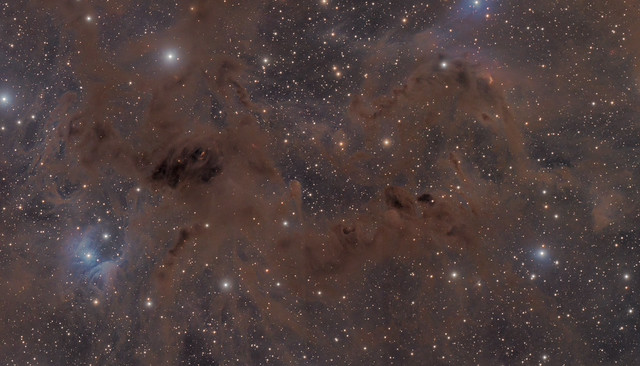 VdB 16 by Carlos Uriarte, en Flickr
VdB 16 by Carlos Uriarte, en Flickr
For me my most complex process to date. Not only for the fact of being 2 tesserae, but for playing with the adversities of so many photos. Because I had to turn down a lot due to high cloud passage in December and early January 2022
For each tile: (11'6h x 2) Total 23.3h
Luminance: 50 600" at BIN 1
40 photos of 300" for each RGB channel BIN 1
Telescope: Takahashi FSQ106 ED
CCD: Atik 460ex mono
 VdB 16 by Carlos Uriarte, en Flickr
VdB 16 by Carlos Uriarte, en Flickr- carlos uriarte
- Ensign
- Posts: 35
- Joined: Sun Oct 13, 2019 6:17 pm
Re: Submissions: 2022 March
Jones-Emberson 1 (PK 164+31.1), also known as the Headphone Nebula, is a 14th magnitude planetary nebula in the constellation Lynx at a distance of 1600 light years. It is a larger planetary with low surface brightness. The 16.8-magnitude central star is a very blue white dwarf.
RGB 24X300" (Each channel)
Halpha 97 x 900"
OIII 65 x 900"
(Total time 46h 30')
Telescope: Skywatcher Esprit 150
CCD: Atik 460EXMono
Mount: Paramount ME
 Jones Emberson 1 by Carlos Uriarte, en Flickr
Jones Emberson 1 by Carlos Uriarte, en Flickr
RGB 24X300" (Each channel)
Halpha 97 x 900"
OIII 65 x 900"
(Total time 46h 30')
Telescope: Skywatcher Esprit 150
CCD: Atik 460EXMono
Mount: Paramount ME
 Jones Emberson 1 by Carlos Uriarte, en Flickr
Jones Emberson 1 by Carlos Uriarte, en FlickrRe: Submissions: 2022 March
NGC2626
Copyright: Wolfgang Promper http://www.astro-pics.com/2626rcm.htm
Copyright: Wolfgang Promper http://www.astro-pics.com/2626rcm.htm
Re: Submissions: 2022 March
NGC3199
Copyright: Wolfgang Promper http://www.astro-pics.com/3199rcm.htm
Copyright: Wolfgang Promper http://www.astro-pics.com/3199rcm.htm
Re: Submissions: 2022 March
NGC3576
Copyright: Wolfgang Promper http://www.astro-pics.com/3576rcm.htm
Copyright: Wolfgang Promper http://www.astro-pics.com/3576rcm.htm
-
Sebastian Voltmer
- Ensign
- Posts: 67
- Joined: Tue Jan 17, 2012 11:45 pm
Re: Submissions: 2022 March
ISS seen through my backyard telescope.
YouTube-Video: https://www.youtube.com/watch?v=peozuHG ... Mg&index=3
Clear skies,
Sebastian
--
Dr. Sebastian Voltmer
www.voltmer.photo
YouTube: spacemovie
Insta: sebastianvoltmer
Click to play embedded YouTube video.
Clear skies,
Sebastian
--
Dr. Sebastian Voltmer
www.voltmer.photo
YouTube: spacemovie
Insta: sebastianvoltmer
-
Mathieu80
Re: Submissions: 2022 March
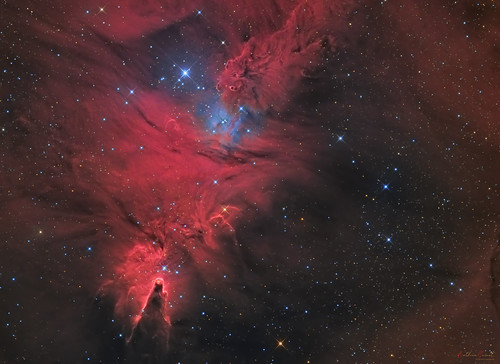 NGC2264 by Mathieu Guinot, sur Flickr
NGC2264 by Mathieu Guinot, sur FlickrThe star forming region NGC 2264 is an open cluster (The Christmas Tree Cluster) associated to emission nebulae (The Cone and the Fox Fur), 2300 light-years away in Monoceros.
The Fox Fur Nebula has a strange shape originate from fine interstellar dust reacting in complex ways with the energetic light and hot gas being expelled by the young stars.
This is a Ha-RGB version emphasising the ionised hydrogen wisps and the colour of the stars.
The bluish area in the centre of the image is a reflection nebula surrounding the star R. Monoceros.
Newton 250mm f/3.8 on IOPTRON CEM70 mount
Camera ZWO ASI2600mm + ZWo EFW + OAG ASI Mini 290mm
10h20 exposures from december to february 2022 in Amiens (Bortle 7).
Halpha : 86 x 300s
RVB : each 30 x 120s
Processing : Pixinsight et Photoshop
Re: Submissions: 2022 March
UGC6614 with a Newton T520 f/4.7
Nikon Z6 sub de 2min à 1600 iso for total exposure 3h50.
Jérôme ASTREOUD and Philippe TOSI. FRANCE
Nikon Z6 sub de 2min à 1600 iso for total exposure 3h50.
Jérôme ASTREOUD and Philippe TOSI. FRANCE
-
mdieterich
- Ensign
- Posts: 99
- Joined: Fri Feb 13, 2015 5:50 pm
Re: Submissions: 2022 March
NGC 1097 with Optical Jets
www.mattdieterich.com
Copyright: Matthew Dieterich This beautiful galaxy known as NGC 1097 has some pretty cool features. If you look closely you can see 3 jets appearing to emanate from the galaxy. These jets are believed to be the remnants of a dwarf galaxy interaction.
Located about 45 million light-years away from Earth, NGC 1097 also has beautiful core structure. On top of that, there is a supermassive blackhole at the center of the galaxy.
Captured with a PlaneWave Instruments CDK600 at ObsTech with Voyager Automation software.
LRGB 307 x 5 min, 50 x 5 min, 63 x 5 min, 65 x 5min.
www.mattdieterich.com
Copyright: Matthew Dieterich This beautiful galaxy known as NGC 1097 has some pretty cool features. If you look closely you can see 3 jets appearing to emanate from the galaxy. These jets are believed to be the remnants of a dwarf galaxy interaction.
Located about 45 million light-years away from Earth, NGC 1097 also has beautiful core structure. On top of that, there is a supermassive blackhole at the center of the galaxy.
Captured with a PlaneWave Instruments CDK600 at ObsTech with Voyager Automation software.
LRGB 307 x 5 min, 50 x 5 min, 63 x 5 min, 65 x 5min.
Re: Submissions: 2022 March
M81 Local Group and IFN
This image shows a well know field centered in M81. In it, several interesting features are visible, namely:
M81: galaxy in the center, a grand design spiral galaxy at 12 Mly where Ha alpha data was highlighted to show its emission nebulas. This February.2022 was reported that a fast radio burst FRB 20200120E, detected in May.2021 may be originated in this galaxy;
M82: top right galaxy, an irregular galaxy gravitically bound to M81. It features proeminent Ha "flares" from its core as a results of it very high rate formation;
NGC 3077: on the left, is a elliptical galaxy, disrupted by its interaction with M81.
Holmberg IX: near M81, at 10 o'clock, is a small dwarf galaxy, satellite of M81
Integrated Flux Nebula: permeating the image, IFN can be seen. This is a fairly new astronomical object and consists in nebula just outside the Milky Way body and only seen due to the reflexion of the integrated light of our galaxy's stars.
This HaLRGB photo was taken using amateur backyard equipment from December.2021 and January.2022, in a total of 47 hours of integration, with the following distribution:
Ha: 272 x 300'' = 22h40; shot at Barcarena, Portugal (Bortle 7)
RGB: 146 x 180'' = 7h18; shot at Barcarena, Portugal (Bortle 7)
LUM: 332 x 180'' = 16h36; shot at Santa Susana, Portugal (Bortle 4)
Higher resolution here: https://flic.kr/p/2nahFNn
This image shows a well know field centered in M81. In it, several interesting features are visible, namely:
M81: galaxy in the center, a grand design spiral galaxy at 12 Mly where Ha alpha data was highlighted to show its emission nebulas. This February.2022 was reported that a fast radio burst FRB 20200120E, detected in May.2021 may be originated in this galaxy;
M82: top right galaxy, an irregular galaxy gravitically bound to M81. It features proeminent Ha "flares" from its core as a results of it very high rate formation;
NGC 3077: on the left, is a elliptical galaxy, disrupted by its interaction with M81.
Holmberg IX: near M81, at 10 o'clock, is a small dwarf galaxy, satellite of M81
Integrated Flux Nebula: permeating the image, IFN can be seen. This is a fairly new astronomical object and consists in nebula just outside the Milky Way body and only seen due to the reflexion of the integrated light of our galaxy's stars.
This HaLRGB photo was taken using amateur backyard equipment from December.2021 and January.2022, in a total of 47 hours of integration, with the following distribution:
Ha: 272 x 300'' = 22h40; shot at Barcarena, Portugal (Bortle 7)
RGB: 146 x 180'' = 7h18; shot at Barcarena, Portugal (Bortle 7)
LUM: 332 x 180'' = 16h36; shot at Santa Susana, Portugal (Bortle 4)
Higher resolution here: https://flic.kr/p/2nahFNn
Re: Submissions: 2022 March
NGC 3166 and 3169 -The Disturbed Galaxy Duo
URL: https://www.kentbiggs.com/images/galaxies/N3166-2.htm
This image contains the two massive "disturbed galaxies" as well as many fainter
galaxies inset and enlarged including a tiny apparent ring galaxy. Click on URL above
for many more details, zoomable image, and animation.
Full screen URL: https://www.kentbiggs.com/images/galaxi ... RGB_4K.jpg
Integration time: 13 hours. Copyright Kent E. Biggs
Clear skies,
www.kentbiggs.com
Houston, Texas
URL: https://www.kentbiggs.com/images/galaxies/N3166-2.htm
This image contains the two massive "disturbed galaxies" as well as many fainter
galaxies inset and enlarged including a tiny apparent ring galaxy. Click on URL above
for many more details, zoomable image, and animation.
Full screen URL: https://www.kentbiggs.com/images/galaxi ... RGB_4K.jpg
Integration time: 13 hours. Copyright Kent E. Biggs
Clear skies,
www.kentbiggs.com
Houston, Texas
Re: Submissions: 2022 March
NGC 4372 and the Dark Doodad
Drifting across the Southern Hemisphere skies some 700 light years away lies The Dark Doodad, a delightful dusty cosmic cloud located in the vast constellation of Musca. Hovering far in the distance (almost 30 times as far away) is NGC 4372 - a globular cluster that just happens to be in the same line of sight as this molecular cloud.
https://www.astrobin.com/pt6uxr/0/
 NGC4372 and the Dark Doodad by Matthew Sole, on Flickr
NGC4372 and the Dark Doodad by Matthew Sole, on Flickr
Imaging Telescope:
SkyWatcher Esprit 100 ED
Imaging Cameras: QHYCCD 268M
Mount: SkyWatcher EQ6-R Pro
Frames:
Astronomik Deep Sky Blue: 190x180" (9h 30')
Astronomik Deep Sky Green: 192x180" (9h 36')
Astronomik Deep Sky Red: 191x180" (9h 33')
Astronomik Luminance L-3: 433x60" (7h 13')
Total Integration::35h 52'
Clear Skies,
Matthew Sole
Drifting across the Southern Hemisphere skies some 700 light years away lies The Dark Doodad, a delightful dusty cosmic cloud located in the vast constellation of Musca. Hovering far in the distance (almost 30 times as far away) is NGC 4372 - a globular cluster that just happens to be in the same line of sight as this molecular cloud.
https://www.astrobin.com/pt6uxr/0/
 NGC4372 and the Dark Doodad by Matthew Sole, on Flickr
NGC4372 and the Dark Doodad by Matthew Sole, on FlickrImaging Telescope:
SkyWatcher Esprit 100 ED
Imaging Cameras: QHYCCD 268M
Mount: SkyWatcher EQ6-R Pro
Frames:
Astronomik Deep Sky Blue: 190x180" (9h 30')
Astronomik Deep Sky Green: 192x180" (9h 36')
Astronomik Deep Sky Red: 191x180" (9h 33')
Astronomik Luminance L-3: 433x60" (7h 13')
Total Integration::35h 52'
Clear Skies,
Matthew Sole
Re: Submissions: 2022 March
Vela Supernova Remnant 18 Panel Mosaic
Original mosaic resolution is 18000 x 12000
Hi Res Link: https://www.astrobin.com/0419rp/B/
Vela Supernova Remnant in HOO with RGB stars
Imaging Telescopes Or Lenses
[William Optics Zenithstar 73
Imaging Cameras
ZWO ASI 1600MM-Pro
Mounts
Skywatcher EQ-6r Pro
Filters
[*]Antlia Pro 3nm Ha · Antlia Pro Oiii 3nm · Antlia Pro Green · Antlia Pro Red · Antlia Pro Blue
Frames:
[*]Antlia Pro 3nm Ha: 243x300" (20h 15') (gain: 139.00) -10°C
Antlia Pro Blue: 1400x15" (5h 50') -10°C bin 1x1
Antlia Pro Green: 1400x15" (5h 50') (gain: 76.00) -10°C bin 1x1
Antlia Pro Oiii 3nm: 243x300" (20h 15') (gain: 139.00) -10°C bin 1x1
Antlia Pro Red: 1400x15" (5h 50') (gain: 76.00) -10°C bin 1x1
Integration:
58h
What started as a single shot rolled into this 18 panel mosaic!
This took me about 18 nights over 2 months to capture due to the weather here in Melbourne.
The mosaic resolution is 18000x12000
With an image of that size, processing was quite a challenge and took a lot of time as each step would require a lot more time than normal process.
The size of this object cannot be underestimated, it is absolutely enormous!
Hi Res Link: https://www.astrobin.com/0419rp/B/
Vela Supernova Remnant in HOO with RGB stars
Imaging Telescopes Or Lenses
[William Optics Zenithstar 73
Imaging Cameras
ZWO ASI 1600MM-Pro
Mounts
Skywatcher EQ-6r Pro
Filters
[*]Antlia Pro 3nm Ha · Antlia Pro Oiii 3nm · Antlia Pro Green · Antlia Pro Red · Antlia Pro Blue
Frames:
[*]Antlia Pro 3nm Ha: 243x300" (20h 15') (gain: 139.00) -10°C
Antlia Pro Blue: 1400x15" (5h 50') -10°C bin 1x1
Antlia Pro Green: 1400x15" (5h 50') (gain: 76.00) -10°C bin 1x1
Antlia Pro Oiii 3nm: 243x300" (20h 15') (gain: 139.00) -10°C bin 1x1
Antlia Pro Red: 1400x15" (5h 50') (gain: 76.00) -10°C bin 1x1
Integration:
58h
What started as a single shot rolled into this 18 panel mosaic!
This took me about 18 nights over 2 months to capture due to the weather here in Melbourne.
The mosaic resolution is 18000x12000
With an image of that size, processing was quite a challenge and took a lot of time as each step would require a lot more time than normal process.
The size of this object cannot be underestimated, it is absolutely enormous!
Re: Submissions: 2022 March

Hi!
Here is my last photo 'The Cosmic Pursuit'.
Full here :
https://www.astrobin.com/cp6o2e/
https://flic.kr/p/2navaL5
Once again I travelled a lot (around 1 000km in 8 days) to get this picture, but when the weather gives you 8 consecutives nights you have to respect that and shot , even if you live in a flat in a bortle 8 city!
It was the hardest project to process I ever did.
First, due to the mixing of the Ha in the LRVB, and adding a HOO version of the planetary nebula.
Then, I felt like the final image looked low contrasted, but it's because the entire field is full of a veil of dust.
I really like this field which brings together a rich variety of what the sky can offer us!
I also like the epic pursuit between this dusty baby bird and a dusty ghost in a Ha set like a theater scene.
Takahashi FSQ106 EDX4 with super reducer 645-QE
Asi 2600MM Pro
Antlia filters L R V B H O (3nm)
Eq6r-pro
Guiding : Altaïr 60/225 + asi 290mm mini
Nebulae :
L : 220x300"
R : 45x300"
V : 45x300"
B : 45x300"
H : 160x600"
O : 105x300"
Stars :
R : 90x10"
V : 90x10"
B : 90x10"
Acquisition : N.I.N.A + Phd2Processing : Siril + PixInsight + Photoshop
Shot in Vosges and Moselle in France on March 3, 4, 5, 6, 7, 8, 9 and 10 2022
Copyright Yann SAINTY
Clear skies
-
Julien Looten
- Ensign
- Posts: 34
- Joined: Tue Mar 08, 2022 7:08 pm
Re: Submissions: 2022 March
A pair of arches in the night sky.


full : https://www.flickr.com/photos/julienlooten/51960538653
Facebook : https://www.facebook.com/Julien.Looten. ... 2059726276
Instagram : https://www.instagram.com/p/CbiWTqKMRnS/
Copyright: Looten Julien
For a long time, I've wanted to make this kind of image, where you can see a "pair" of arches in the night sky: the arch of the Milky Way and the arch of the zodiacal light which seem to "intersect ". To take this photo, I had to take into account several parameters: wait for a clear night, a clear sky, and find a place free of light pollution.
The arch of the Milky Way is here, in its entirety, thanks to a 180° panorama, from south (left) to north (right). Left: Sirius and the Orion's constellation. In the center: the Pleiades and the California nebula. On the right: the constellation of Cassiopeia, the double cluster of Perseus and the Andromeda Galaxy.
In autumn or spring, the zodiacal light is visible all along the elliptical plane when it is tilted with respect to the horizon.
This light is caused by sunlight reflecting off space dust (most of it from Martian storms). In this image, the zodiacal light takes shape in the west/northwest, under the Milky Way, and extends beyond it to the north.
The whole is reflected in the water mirror of Hostens's Lake, whose banks seem to form a third arch (inverted)….??? I love this kind of photography, for which there is so much to say and explain…
Panorama of 18 photographs (3200iso - 30s) taken with a Samyang 14mm (f/2.8) and the Canon 6d Astrodon (modified for astrophotography). Photoshop processing. At Hostens's lake (35km south of Bordeaux). 03/23/2022.
thank you in advance.


full : https://www.flickr.com/photos/julienlooten/51960538653
Facebook : https://www.facebook.com/Julien.Looten. ... 2059726276
Instagram : https://www.instagram.com/p/CbiWTqKMRnS/
Copyright: Looten Julien
For a long time, I've wanted to make this kind of image, where you can see a "pair" of arches in the night sky: the arch of the Milky Way and the arch of the zodiacal light which seem to "intersect ". To take this photo, I had to take into account several parameters: wait for a clear night, a clear sky, and find a place free of light pollution.
The arch of the Milky Way is here, in its entirety, thanks to a 180° panorama, from south (left) to north (right). Left: Sirius and the Orion's constellation. In the center: the Pleiades and the California nebula. On the right: the constellation of Cassiopeia, the double cluster of Perseus and the Andromeda Galaxy.
In autumn or spring, the zodiacal light is visible all along the elliptical plane when it is tilted with respect to the horizon.
This light is caused by sunlight reflecting off space dust (most of it from Martian storms). In this image, the zodiacal light takes shape in the west/northwest, under the Milky Way, and extends beyond it to the north.
The whole is reflected in the water mirror of Hostens's Lake, whose banks seem to form a third arch (inverted)….??? I love this kind of photography, for which there is so much to say and explain…
Panorama of 18 photographs (3200iso - 30s) taken with a Samyang 14mm (f/2.8) and the Canon 6d Astrodon (modified for astrophotography). Photoshop processing. At Hostens's lake (35km south of Bordeaux). 03/23/2022.
thank you in advance.



